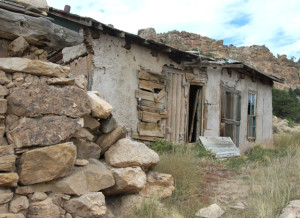by John Mattingly
Colorado Central readers who have driven through the San Luis Valley on Hwy. 17 and looked east between Roads Z and X may have noticed large herds of cloven-hoofed and horned creatures interrogating the grass and brush inside a six-foot-high woven wire fence enclosing about 800 acres. The above-mentioned creatures are, for the most part, goats. On any given day, to be more specific, approximately 500 goats. Of course, the only way to count goats is to count the legs and divide by four. In other words, the same principal of precision that applies to wealth (if you know exactly how much money you have, you’re not really wealthy) applies to goats: if you know exactly how many goats you have, you are not really in the goat business.
Kidding aside, Tim Morgan, owner and sole operator of Morgan Goat Company, is in the goat business. To understand what this means, there are four basic kinds of livestock operations: hobby, feral, speculative and commercial (business). Many livestock operations, including most cattle ranches, are actually subsidized hobbies, to one degree or another. I went into some detail on the hobby nature of most cattle ranches in a prior series, and likewise, many goat operations are run as a hobby. The key distinctions being: does the operation make a profit, and does it serve as the sole source of income for the operator? If not – if there is a trust fund, a job in town, an inherited arrangement for cheap feed or pasture, an oil well or a calculated tax break in the mix – the livestock operation is a hobby of some stripe. Especially if all the creatures in the herd have names.
Some livestock operations are feral. That is, the creatures run free on large ranches, or “stations” as they are called in Australia, and the operators round them up periodically and sell them. Other livestock operations are speculative, such as amplifying mating pairs of emus or raising purebred animals for show. Anyone who has been to the National Western Stock Show and seen cattle being shampooed and their tails combed into hair balls has seen one peculiar manifestation of the purebred cattle scene.
[InContentAdTwo]
Morgan Goat Company is a business, a strictly commercial operation that runs on four legs: breeding stock production (which includes a breeding herd of about 500 nannies and 400 ewes), weekly trading, order buying and weed/brush mitigation.
Breeding stock production. Tim’s operation runs a steady breeding stock herd that produces kids and lambs, providing the foundation of the business. Breeding is timed to produce maximum marketable stock during peak demand periods: December and April. The breeding operation has several advantages over a cattle operation. Goats and sheep are more efficient than cattle at converting carbohydrates (grass or corn) into protein (meat). Typically, cattle require about eight pounds of feed to produce a pound of flesh while goats require about four pounds, and goats can utilize a lot of roughage, such as brush and thistles, that cattle cannot. Goats and sheep reproduce in multiples with a gestation roughly half that of cattle, who reproduce mostly in singles with a nine-month gestation. Early humans domesticated sheep and goats for meat, milk and hides, reserving cattle for beasts of burden because cattle were simply too inefficient at reproduction and feed conversion to be multiplied as a food source.
“Do you milk all those goats?” is a frequent question asked of Tim Morgan about his goat business. A large and generous man, Tim smiles and explains that his operation is exclusively a fresh meat business, serving a growing population of Middle Eastern and Hispanic consumers. As the standard of living has risen in the U.S., the cultural populations that ate mostly chicken have graduated to eating red meat, and goat meat is preferred. The Boer goat of about 120 pounds is the equivalent of prime Angus to Middle Eastern consumers.
Leg of lamb, lamb chops and ribs have aways been a small and select staple in U.S. supermarkets, demand being highest around Easter. Many people marvel at the rise and popularity of goat meat. It is available frozen in high-end supermarkets like Trader Joes and Sprouts and sometimes Whole Foods, but there is an active fresh meat market in Colorado for goat meat that meets the standard of weight and condition.
Weekly trading and order buying. Tim runs an active trading operation, going to at least three, and as many as six, livestock sales in the mountain region every week to bid on odd lots that he packages for sale that same week to retail meat buyers.
“Every sale has opportunities,” Tim points out. While I know this to be true of auctions in general, I also know that Tim has the remarkable patience required to sit an entire day watching goats and sheep come through the offering ring at the sale barn, and then bidding on this or that group that can be matched or paired with another group that, as a result of the combination, is more valuable. This skill of patience and a keen eye gives Tim a handy and profitable side business as an order buyer for other operations who lack the time and/or patience to take an entire day at the sale barn. Tim is on the phone every sale day, making deals, taking orders and putting together packages of goats and sheep. He’s even been known to buy and sell the same day at the sale barn to other traders who missed a trick.
There are also large goat herds in Texas and Oklahoma that are semi-feral; Tim buys these large herds of 500 to 1,000 goats coming off large ranches, where the goats are used to eat down brush and tall weeds and “clean up” after the cattle, meaning the goats will eat what the cattle will not. Tim then sorts and packages the goats for various buyers.
The trading and order buying operations provide weekly cash flow to back up and support the breeding operation, which is more stable, but yields less regular revenue.
Weed and brush mitigation. Tim can supply goats – for a fee, of course – to mitigate weeds and brush on ski slopes and in urban areas that are inaccessible to mowing machinery. This work can be accomplished with odd-lot goats of undistinguished pedigree that do not fit with other goats, but are well suited to mitigation chores.
A final characteristic of a commercial goat operation is that the animals are treated with respect, but not as pets. Hobby operations tend to overfeed and pamper their animals, while a commercial operation must develop a grass-rustler mentality in the herd. And hobby operators see a dead animal and think the operator should have a funeral and bury the poor creature with a headstone. But a large commercial operation simply accepts that, over time, about two percent of the herd will die from any of a great variety of causes, from predation to disease, and the carcasses of dead animals will often be used to bait predators.
As Tim heads out to walk the pasture to check the condition of his stock, or hitch up his trailer to prepare for a day at a sale barn, he looks back with a grin, “This is what I do, and I like it.”
John Mattingly cultivates prose, among other things, and was most recently seen near Poncha Springs.




